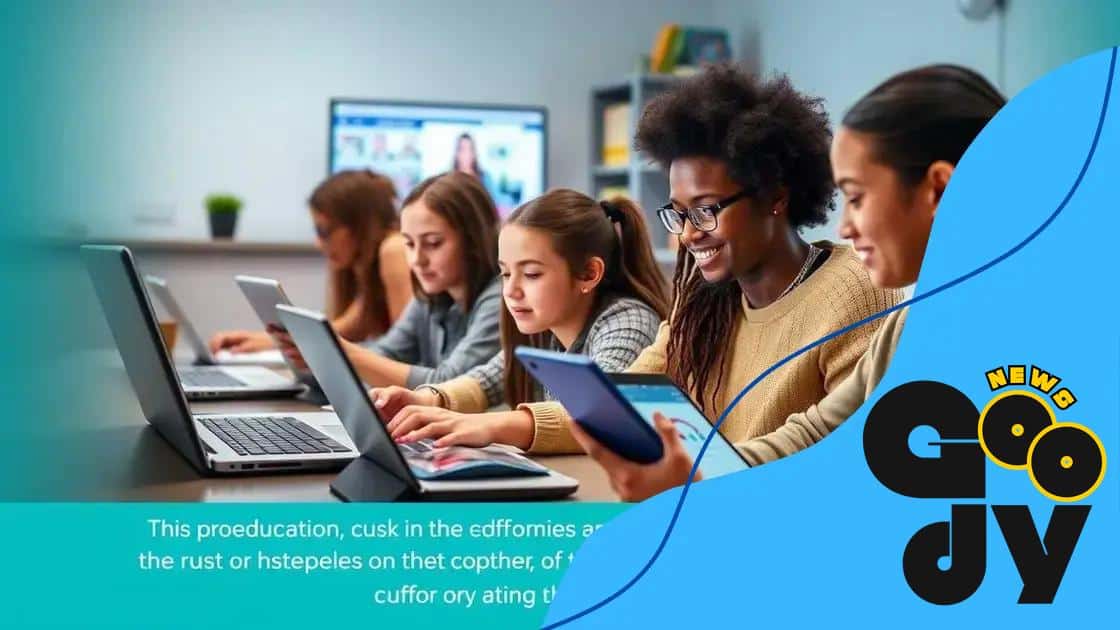Remote learning technologies: transforming education for all

Remote learning technologies enable flexible, accessible education through innovative tools like AI, VR, and collaborative platforms, while also presenting challenges such as engagement and technical issues.
Remote learning technologies have changed the educational landscape in recent years. Have you ever wondered how these advancements can enhance learning? Let’s dive into the various ways technology is making education more accessible.
Understanding remote learning technologies
Understanding remote learning technologies is essential in today’s educational landscape. These technologies allow students to learn from anywhere, making education more accessible than ever.
One key aspect of remote learning is the variety of tools available. These platforms can enhance the overall learning experience by providing interactive and engaging content. Some popular tools include:
Common Remote Learning Tools
- Video Conferencing: Platforms like Zoom and Microsoft Teams facilitate live lectures and discussions.
- Learning Management Systems (LMS): Tools like Moodle and Google Classroom help organize course materials and track student progress.
- Interactive Content: Resources such as Kahoot! and Quizlet make learning fun and engaging through games and quizzes.
Additionally, remote learning technologies help tailor education to individual needs. Students can learn at their own pace, revisit lessons, and access resources easily. This personalized approach is one of the greatest advantages of online education.
Moreover, many educators are adopting blended learning models, combining traditional and online methods. This hybrid approach allows for greater flexibility, meeting the needs of diverse learners.
In conclusion, grasping remote learning technologies leads to a more enriching educational journey. These innovations offer tools that benefit both students and educators, paving the way for future growth in education.
Benefits of remote learning for students
The benefits of remote learning for students are numerous and significant. These advantages make education more flexible and accessible, appealing to a wide range of learners.
One primary benefit is the ability to learn from any location. Students can attend classes from home or while traveling, which removes geographical barriers. This flexibility is especially important for those with busy schedules or commitments outside of school.
Key Benefits
- Customizable Learning Environment: Students can choose their ideal study space, whether it’s a quiet room or a local café.
- Self-Paced Learning: Online platforms allow students to learn at their own speed, revisiting challenging topics as needed.
- Access to Resources: Many remote learning platforms provide access to a wealth of online resources, including videos, articles, and interactive exercises.
Moreover, remote learning encourages the development of important skills. Students often become more self-disciplined and independent as they manage their own schedules. They also learn to navigate various digital tools, preparing them for future workplaces.
Another major advantage is the potential for increased participation. Online classes often encourage students to engage in discussions more freely, as they might feel less intimidated than in a traditional classroom setting.
In addition to these benefits, remote learning fosters a sense of community through online collaboration. Students can connect with peers from diverse backgrounds, promoting cultural exchange and understanding.
Tools and platforms for effective online education

Tools and platforms for effective online education play a crucial role in enhancing the learning experience. These technologies enable students and educators to engage with content in innovative ways.
There are many platforms available, each offering unique features. These tools facilitate interactive learning and collaboration among students, regardless of their location.
Popular Online Education Platforms
- Zoom: A leading video conferencing tool that allows live classes and discussions.
- Google Classroom: A comprehensive learning management system that organizes assignments and resources effectively.
- Moodle: An open-source platform known for its flexibility, catering to various educational needs.
- Edmodo: A social learning network that connects teachers, students, and parents.
Many of these platforms provide valuable resources to improve engagement. For instance, quizzes, polls, and discussion boards encourage student participation. Incorporating various media types, such as videos and podcasts, enhances understanding of complex topics.
Additionally, tools like learning analytics help educators track student progress. This information allows teachers to customize lessons to better meet their students’ needs. For instance, if a student struggles with a particular topic, additional resources can be provided.
As technology evolves, so do the tools available for online education. Schools and universities continuously explore new ways to enhance the learning experience. Innovations such as virtual reality are beginning to emerge in classrooms, offering even more dynamic learning opportunities.
Challenges faced in remote learning environments
Challenges faced in remote learning environments are significant and can impact the overall educational experience. While online education offers flexibility, it also presents unique difficulties for both students and educators.
One major challenge is maintaining student engagement. Without the traditional classroom environment, some students may feel isolated. This can lead to decreased motivation and participation in online courses.
Common Challenges
- Technical Issues: Students may encounter problems with internet connectivity or device compatibility that hinder learning.
- Lack of Interaction: Remote learning can limit opportunities for social interaction, which is important for developing communication skills.
- Distractions at Home: The home environment can be full of distractions, making it difficult for students to focus on their studies.
Additionally, educators face challenges when trying to facilitate effective online lessons. Adjusting teaching methods to suit a digital format requires time and training. Teachers often need to master various technologies while also crafting engaging lesson plans.
Another concern is ensuring all students have equal access to resources. While some may thrive in a remote setting, others may struggle without appropriate support. This inequality can affect learning outcomes and widen educational gaps.
Lastly, mental health issues are on the rise due to the social isolation and uncertainty of the current landscape. It’s crucial for both students and educators to prioritize mental well-being to create a supportive learning environment.
Future trends in remote learning technologies
Future trends in remote learning technologies are evolving rapidly, shaping how education is delivered across the globe. As technology advances, we can expect significant changes that will enhance the learning experience.
One prominent trend is the integration of artificial intelligence (AI) into online education. AI can personalize learning experiences, adapting content to fit individual student needs. This technology analyzes student performance and suggests resources, helping learners progress at their own pace.
Emerging Technologies
- Virtual Reality (VR): VR offers immersive experiences that can simulate real-world scenarios, making learning more engaging.
- Augmented Reality (AR): AR enhances real-world environments with digital information, providing interactive learning opportunities.
- Gamification: Incorporating game design elements into education can motivate students and increase participation.
Additionally, a shift towards more collaborative learning environments is expected. Online platforms will likely facilitate group projects and discussions in real time, enabling students to work together, regardless of their location.
Moreover, the demand for flexible learning solutions will continue to grow. Students will seek options that fit their lifestyles, leading to more asynchronous learning opportunities. This flexibility allows individuals to learn on their own terms, balancing studies with personal commitments.
Data analytics will also play a crucial role in shaping the future of online education. By tracking student engagement and performance, educators can refine their teaching methods and materials, ensuring they meet diverse learning needs.
remote learning technologies are transforming education in exciting ways. They offer flexibility and accessibility, allowing students to learn at their own pace and from anywhere. As we look to the future, innovations like AI, VR, and collaborative platforms will reshape how education is delivered, making it more interactive and personalized. While challenges exist, the benefits of remote learning outweigh them, providing opportunities for growth and development in today’s digital world.
FAQ – Frequently Asked Questions about Remote Learning Technologies
What are remote learning technologies?
Remote learning technologies include online platforms and tools that facilitate education from anywhere, allowing students to engage in learning without being physically present in a classroom.
How does AI enhance remote learning?
AI can personalize learning experiences by analyzing student performance and suggesting tailored resources, making education more effective and engaging.
What are some common challenges in remote learning?
Common challenges include maintaining student engagement, technical issues, distractions at home, and ensuring equal access to resources for all students.
What future trends should we expect in remote learning?
Future trends include increasing use of AI, virtual reality, gamification, and enhanced collaborative platforms that facilitate group work and interactive learning.





